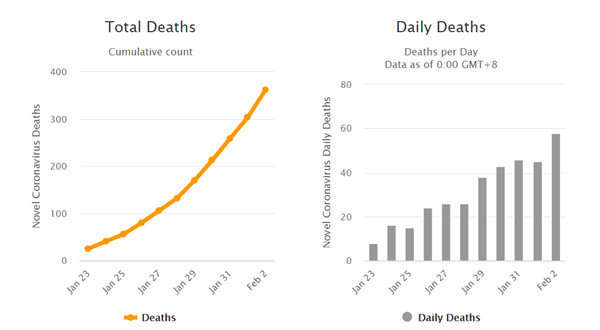The World Health Organization declared on 30th January 2020 that the Wuhan coronavirus is a global health emergency. The decision to declare the outbreak an emergency was not because of the rapidly growing number of cases in China, but because the expert panel was worried about the virus spreading to other countries with weaker health systems.
Reading in the New York Times, the tone is deteriorating quickly.
“It’s very, very transmissible, and it almost certainly is going to be a pandemic,” said Dr. Anthony S. Fauci, director of the National Institute of Allergy and Infectious Disease.
“But will it be catastrophic? I don’t know.”
In the last three weeks, the number has soared to more than 20 000 in at least 23 countries; resulting in 427 deaths.

The Basics of the Outbreak
The virus was first identified on 31st December 2019 and is believed to have originated from the Wuhan food market which is referred to as a “wet market”. Wet markets put people and live and dead animals (such as dogs, bats, chickens, ducks, snakes to name a few) in constant close contact. This makes it easy for a virus to jump from animal to human.
What is A Coronavirus?
The Coronaviruses are a family of viruses that cause infections in the respiratory system. There are seven known coronaviruses including the newly identified 2019-nCoV. SARS (Severe Acute Respiratory Syndrome) was the coronavirus behind a deadly outbreak from 2002 to 2003 which infected 8, 098 people and killed 744. MERS (Middle East Respiratory Syndrome) was first identified in 2012, which is another recent and ongoing coronavirus outbreak, with cases reported as recently as last week.
How Deadly is this Disease?
The short answer is we do not know but so far, the indication is that about 2% of people who get the disease die. Like many other diseases, patients are more likely to die if they suffer from other ailments or have weaker constitutions. What is encouraging is that the number of people who have recovered has been rising, suggesting that the new virus’s fatality rate is relatively low.
How did the Outbreak Start?
The CDC (Centre for Disease) says that the initial cases of the 2019-nCoV are linked to the Hua Nan Seafood Market in Wuhan. It most likely started from a “spillover” incident when the virus was passed from animal to human. This can happen through close human-to-animal contact, especially where live and dead animals are sold for food at markets. The Wuhan market was shut down on January 1st.
How does the disease spread? Should we start wearing masks?
It is not clear how the virus is being transmitted, or how easily it can move from person-to-person. What we do know, is that it can move from person to person. Cornaviruses typically spread through the air when a person sneezes or coughs. If this strain works the same way, then the face masks might offer some protection. Since droplets from coughs and sneezes tend to end up on surfaces other people touch, frequent washing of hands is also recommended. Furthermore, China’s National Health Commission said that unlike SARS the Coronavirus is also contagious before patients show symptoms, this means that it could be spread more easily, since people could be transmitting the disease before they are even aware that they are sick.
Prevention
The signs present as respiratory symptoms, fever, cough, shortness of breath and breathing difficulties, in more severe cases, infection can cause pneumonia, severe acute respiratory syndrome, kidney failure and even death.
Standard recommendations to prevent infection spread include regular hand washing, covering mouth and nose when coughing and sneezing, thoroughly cooking meat and eggs and avoiding close contact with anyone showing symptoms of respiratory illness such as coughing or sneezing.
Secondary effects of the virus
- China will pump 150 billion yuan (about ZAR320 billion) into the local economy and cut taxes to lift the economy and confidence
- The Xiaotangshan hospital was built in 7 days which is believed to be a new world record – click here to see more amazing pictures
- Fears of the virus have caused oil prices to drop substantially
- Foreign nationals will not be allowed to enter the US if they have been to China in the preceding two weeks
- A lot of flights to China have been cancelled
- More than 50 research papers have been published in the last 20 days




